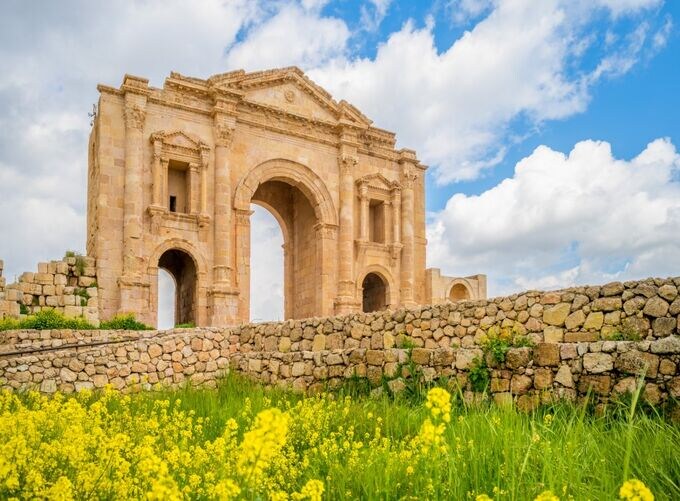
10 Fascinating Facts You Never Knew About Jordan
Jordan, a country steeped in history and rich in culture, is often known for its iconic sites like Petra and the Dead Sea. However, there are numerous lesser-known aspects of Jordan that make it an intriguing and unique destination. From its hidden treasures to fascinating cultural practices, this blog explores ten surprising facts about Jordan that you might not know.
Jordan’s Unique Position in the Bible
Jordan holds a special place in Biblical history, with several sites of significant religious importance. While many travelers are familiar with Petra and the Dead Sea, fewer know that Jordan is home to several other key Biblical locations:
Bethany Beyond the Jordan:
This is believed to be the site where Jesus was baptized by John the Baptist. It is one of the most important pilgrimage sites for Christians and was designated a UNESCO World Heritage site in 2015.
Mount Nebo:
According to the Bible, this is where Moses was granted a view of the Promised Land before his death. The site offers stunning views of the Jordan Valley and is home to ancient mosaics.
These locations, steeped in religious significance, add a profound layer to Jordan’s historical tapestry.
The Dead Sea Is the Lowest Point on Earth
The Dead Sea is renowned for its incredibly high salt concentration, which allows people to float effortlessly on its surface. However, a lesser-known fact is that the Dead Sea is the lowest point on Earth. Located at approximately 430 meters (1,411 feet) below sea level, it is part of the Jordan Rift Valley, a tectonic plate boundary that stretches from Syria to Mozambique.
This geological feature contributes to the unique mineral content of the Dead Sea, which has been used for therapeutic purposes since antiquity. The mud and water from the Dead Sea are known for their purported skin benefits, and the area is a popular destination for wellness tourism.
Jordan’s Desert Landscape is a Filmmaker’s Paradise
Jordan’s dramatic desert landscapes have made it a favored location for filmmakers seeking to create stunning, otherworldly scenes. The most famous of these is Wadi Rum, often referred to as the “Valley of the Moon” due to its otherworldly terrain.
Lawrence of Arabia:
The 1962 film, directed by David Lean, used Wadi Rum as a key filming location. The area’s vast sandstone mountains and red sands perfectly captured the essence of the Arabian desert.
The Martian:
Ridley Scott’s 2015 film featured scenes filmed in Wadi Rum to depict the Martian landscape. The striking desert scenery of Jordan provided the ideal backdrop for the science fiction narrative.
These film productions have showcased Jordan’s breathtaking landscapes to a global audience, adding to its allure as a travel destination. Jordan tours
Jordan is Home to the Ancient Nabatean City of Petra
Petra, one of the New Seven Wonders of the World, is undoubtedly Jordan’s most famous site. However, the story of Petra and its significance extends beyond its impressive architecture:
Architectural Marvel of Jordan:
Petra was carved into the rose-red cliffs of southern Jordan by the Nabateans, an ancient Arab tribe, around the 4th century BC. The city was a major trading hub due to its strategic location along the Incense Route.
Rediscovery:
Although Petra was known to locals, it was not widely known to the Western world until it was rediscovered by Swiss explorer Johann Ludwig Burckhardt in 1812. His exploration reignited interest in this ancient city.
Petra’s intricate rock-cut architecture and historical significance make it a must-see for anyone visiting Jordan.
Jordan Hosts the World’s Largest Nature Reserve
Jordan is home to the world’s largest nature reserve, the Wadi Rum Protected Area, also known as the Wadi Rum Nature Reserve. This reserve covers approximately 720 square kilometers (278 square miles) and is renowned for its spectacular landscapes and diverse wildlife.
Flora and Fauna:
The reserve supports a variety of plant species, including desert wildflowers, and wildlife such as foxes, ibexes, and numerous bird species. It is also a site of archaeological interest, with ancient petroglyphs and inscriptions left by past civilizations.
Cultural Heritage of Jordan:
The reserve is inhabited by the local Bedouin community, who have a rich cultural heritage and traditional knowledge of the land. They offer guided tours to Jordan and experiences, providing visitors with insights into Bedouin life and the natural environment.
Wadi Rum’s vast desert vistas and rich biodiversity make it a unique and vital part of Jordan’s natural heritage.
The City of Madaba is Famous for its Ancient Mosaics
Madaba, a town located in central Jordan, is known for its ancient mosaics, which are among the most well-preserved and significant in the world:
Madaba Map:
The most famous mosaic is the Madaba Map, a 6th-century Byzantine mosaic that depicts a detailed map of the Holy Land. It is one of the earliest surviving maps of the region and provides valuable historical and geographical insights.
Other Mosaics:
In addition to the Madaba Map, the town is home to numerous other mosaic floors found in churches and public buildings. These mosaics feature intricate designs and scenes from daily life in antiquity.
Madaba’s rich mosaic heritage adds a fascinating cultural dimension to Jordan’s historical landscape.

The Red Sea’s Coral Reefs are a Snorkeler’s Paradise
Aqaba, Jordan’s coastal city on the Red Sea, is renowned for its stunning coral reefs and marine biodiversity. The underwater world of the Red Sea offers a vibrant and colorful experience for snorkelers and divers:
Coral Reefs:
Aqaba’s coral reefs are among the northernmost in the Red Sea and are home to a diverse array of marine life, including colorful fish, sea turtles, and rays. The clear waters provide excellent visibility for underwater exploration.
Marine Conservation:
Jordan has made significant efforts to protect its marine environment, including the establishment of marine reserves and regulations to preserve coral reefs and marine species.
Aqaba’s pristine coral reefs make it a Jordan's top destination for those interested in underwater adventure and marine conservation.
Jordan Has a Thriving Arts and Culture Scene
Jordan’s arts and culture scene is dynamic and reflects the country’s rich heritage and modern creativity:
Contemporary Art of Jordan:
Jordan has a growing contemporary art scene, with galleries and exhibitions showcasing the work of local artists. The Jordan National Gallery of Fine Arts in Amman is a prominent institution supporting contemporary art.
Traditional Music and Dance:
Jordanian music and dance traditions include performances of Bedouin folk music, traditional dance forms like the debke (a folk dance), and classical Arabic music. These cultural expressions are often featured at festivals and cultural events.
Jordan’s vibrant arts and culture scene provides a rich and varied experience for visitors interested in the country’s creative expressions.
Jordan’s Conservation Efforts Preserve Its Natural and Cultural Heritage
Jordan is committed to preserving its natural and cultural heritage through various conservation initiatives:
Petra Development and Preservation:
The Petra Archaeological Park is managed by the Petra Development and Tourism Region Authority (PDTRA), which oversees conservation efforts and infrastructure development to protect and enhance the site.
Protected Areas:
Jordan has established numerous protected areas, including national parks and nature reserves, to safeguard its unique ecosystems and wildlife. These efforts support sustainable tourism and environmental conservation.
Cultural Heritage Projects:
Jordan is actively involved in projects to preserve its cultural heritage, including the restoration of historical sites and the promotion of traditional crafts and practices.
Jordan’s dedication to conservation ensures that its natural and cultural treasures are preserved for future generations to enjoy.
Visit Jordan: A Journey Through Rich Heritage
Jordan is a country rich in history, culture, and natural beauty, with many lesser-known aspects that make it a unique and fascinating destination. From its hidden historical sites and culinary delights to its stunning desert landscapes and vibrant arts scene, Jordan offers a wealth of experiences for travelers.



